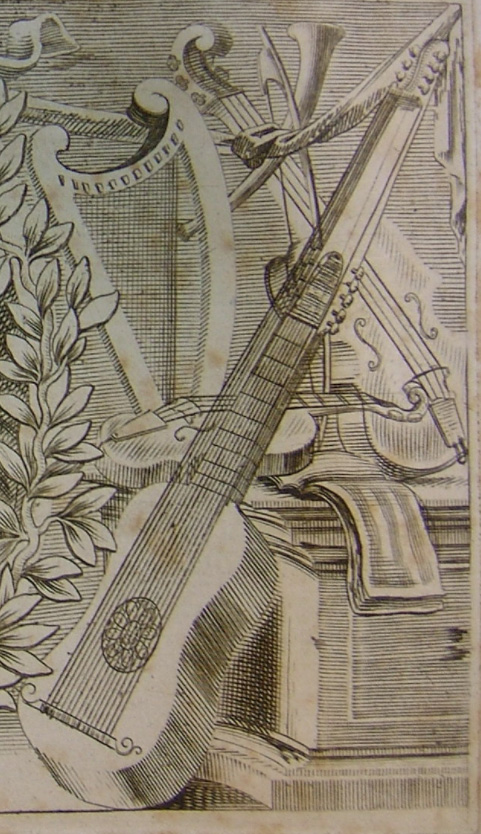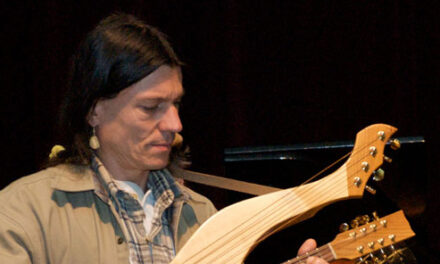Welcome to this follow-up to my previous article where I presented a complete-to-date overview of the first two centuries of possible theorbed guitars (the earliest form of harp guitar).
Since 1976 when Robert Spencer initiated the topic with his 3-page article (Early Music, Vol. 4, no. 2), a growing number of Baroque and historical guitar players, builders and scholars have explored the subject – with the more adventurous going as far as building and playing instruments they see as recreations or interpretations of some of the instruments known from the historical clues.
So far, these have fallen into four general categories: “Grammatica-style” lute-based instruments, “Granata-style” instruments, Stradivari’s “lost theorboed guitar,” and 5- or 6-strings-on-the-neck “late 18th century French-style” instruments. It goes without saying that readers will benefit from first becoming familiar with my previous article; feel free to keep my Reference Table handy as well.
The first experiment I’m aware of was in 1998, when Stephen Barber & Sandi Harris of lutesandguitars.co.uk took Spencer’s theories literally and built an accurate physical copy of the Grammatica instrument from the painting shown here.

Again, while it looks like and is constructed like a lute, it is believed to have been tuned like a guitar. Barber and Harris referred to it as a “chitarrone francese,” which came directly from Spencer’s premise.
They followed that up with a second one in 2004 for the English baroque guitar player Jim Bisgood, as seen next:

They said that it was “very closely modelled on the Grammatica painting, including the decoration and rose design.” Note that it has the same 5 neck courses and 9 single bass strings, which Bisgood intended to tune and play as a theorboed guitar. I’ve never been able to track him down nor any images of him with the instrument.
The second physical Grammatica recreation was by Berlin’s Wolfgang Emmerich, who built his below in 2008.

It’s also very close to the Grammatica painting except that it has 11 tuners for six neck courses. This was so that it could alternatively be strung and used as the more common arciliuto if desired. Note that only 5 courses were strung for the photo and video demo. The versatile and talented Rob MacKillop briefly borrowed it and did this demonstration and performance of two Granata pieces: Sarabande and Corrente.
In the two examples above, the luthiers were specifically striving to recreate the physical instrument in the Grammatica painting (c.1615), while calling it the “Chitarrone Francese” (1733). However, the two instruments were over a hundred years apart, and the chitarrone francese had only 5 basses; the imagined connection came from the original sleuth Robert Spencer in his 1976 article. Confounding things further is that MacKillop chose to play something written for yet a third instrument – Granata’s chitarra atiorbata.
As for this linking of the named 1733 instrument with the early 1600s Grammatica illustration, my stance is simple (stemming from my discoveries over the years of dozens of often unrelated harp guitar inventions and experiments). Namely: Why do any of these clues need to “match up”? Why not the occasional experimentation with these obvious ideas, resulting in a continual series of “one-off builds” that might or might not garner a name, or some written music, or once in a while perhaps even influence a small “movement”? Still, I’m thrilled with the curiosity and dedication of both the luthiers and customers above for wanting to explore the mysteries of the painting and the equally mysterious chitarrone francese.
For our next examples, the inspiration was both Granata’s music and the reputed instrument (below) discussed in my previous article. Players and builders here stuck specifically to the period’s five neck courses.


Above: One of the first was built in 1986 by Carlos Gonzales (Spain) for Javier Hinojosa (Mexico), when both were working in Paris. It followed the stringing of the Granata instrument except for including an additional tuner for the first course (left unstrung). Carlos subsequently built several more theorboed Baroque guitars of 11, 12 and 13 courses (see further below).

Above: Another was built in 2010 by Christopher Davies of Portland, Oregon for Hideki Yamaya. Though Davies described it as “own interpretive design,” it seems to adhere pretty closely to the engraving basics – including the straighter extension and “fold-over” bass head of most theorboes. Hideki told me “Alas, the theorbed guitar was sold. It was the instrument that got the least amount of use. To be honest, Christopher built it (while I consulted) as an experiment, but it was kind of an awkward instrument: a little too ringy and deep for a lot of strumming, and not enough bass to replace a theorbo. But it was fun, and I did play some pieces by Granata and (lutenist) Losy in concert.”
In 2014, Carlos Gass of Spain built a similar Granata-style 7+5-course instrument (his second theorboed guitar) for Spanish guitarist Thomas Schmitt:


Again, it is a “best guess” practical reconstruction of the instrument shown in the engraving. They too included an unused second tuner for the top course. Interestingly, in Schmitt’s two videos with the instruments, he first plays a Granata piece, then a Gallot piece – the latter he plays in the same standard tuning rather than the open C.
Other historical music performers occasionally play the Granata material, using different forms of theorbed or harp guitars.
One of the more fascinating theorboed guitar forms is the Strad “chitara tiorbata” from the early 1700s. Some time ago, Spain’s Carlos Gonzales shared with me this drawing that he extrapolated from the two small cardboard template pieces that Stradivari left us:

Carlos says “In fact we only have the drawing of the neck and double headstock. The body of mine is based on the largest Strad guitar body that I measured at Paris (#1711 at the Museum of Paris, shown below), which is the largest I know of and which I made the drawings of many years ago, when I worked at the museum. The result is more logical, with a string length on the neck of 71cm and 145cm for seven extended basses.” Carlos says he finally plans to start two of these instruments this February.

If you think the neck in Carlos’ drawing looks a little extreme, well…

Rome luthier Carlo Cecconi built this wonderful five-foot-long Strad interpretation for guitarist Maurizio Scavone, who similarly studied the same Granata and Gallot music, along with the anonymous Neapolitan manuscript for “catarra.” I haven’t heard of any videos or recordings yet.


Now we jump a few decades into the future and over to France for the late 18th century theorboed guitars like these at left. I know of only one lucky gentleman who actually owns and performs on an original example: David Jacques, shown below with his asymmetrical c.1790 Villaume & Giron.


Others have commissioned new instruments. The first may have been Felippe Maravalhas of Brazil, who asked Luciano Faria in 2004 to copy the earlier Paris specimen above left, including the “rope” binding, moustache bridge and 3-dimensional parchment rosette. They chose to give it a 6-string neck. Faria made at least one additional simpler version, then retired due to personal issues.

.Also inspired by the Paris instrument, Brazilian guitarist Alvaro Henrique (below) recently commissioned a 5+6 instrument from Hugues Boivin.

Getting back to Carlos Gonzales (shown below), to date he’s built over a dozen modern and historical theorboed guitars of his own design.

This one (ablve and below) looks much like one of the later 18th century streamlined theorboed guitars, but is configured like the Granata instrument, with five doubled neck courses and seven basses.
I’ve found notices of its owner, Geoffrey Morris of Melbourne, concertizing with others and using this instrument.

All the instruments here are certainly beautiful, and we’ve heard them make lovely music. I hope the trend continues!






Thanks for including my video, Gregg. I’m a bit embarrassed about it, though, as I didn’t have time to do any research at all. I was just presented with the instrument and some sheet music, and I had a very busy week of teaching. My time on the instrument amounted to about four hours in total. Still, it was fun to do, and I would still be interested in recording the Granata on a proper instrument someday. This page of yours is inspiring!
Rob MacKillop
I almost had a heart attack when I saw the gorgeous Chitarrone Francaise facedown on asphalt! So much, in fact, that it took me half an hour before I could read the article :-). But boy, are those beautiful instruments. Barber & Harris have some incredible shop photos on their site, showing details of their building process. A whole new bag of rabbits.
Thanks Gregg! Wonderful article; exactly as we’ve become accustomed to [and absolutely spoiled by].
p.s. Some use cardboard pieces as invisible supports, but that’s like saying that John Hurt’s stomach ache was just a movie trick :-).